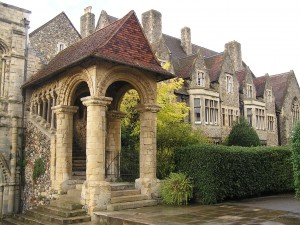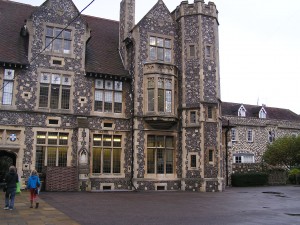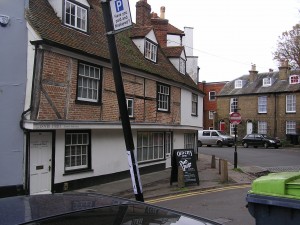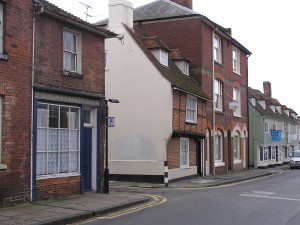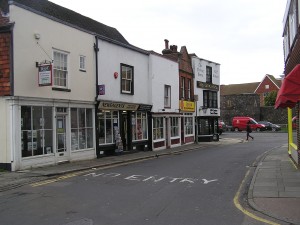
No.2 Dover Street, Canterbury (second building from right) - scene of Patrick Leigh Fermor's romantic encounter with Nellie Lemar. The city walls are in the distance
The King’s School, Canterbury, in the precincts of the Cathedral, is reputedly the oldest school in the world. Believed to have been founded by St Augustine in 597, it was incorporated by Henry VIII in 1541. Its foundationers are called ‘King’s Scholars’ in his memory.
For Patrick Leigh Fermor, who attended the school from 1929 to 1932, there was ‘a wonderfully cobwebbed feeling about this dizzy and intoxicating antiquity’ (Time of Gifts, p.15). Paddy boarded in The Grange (now the music department), where his housemaster was Alec Macdonald. Humane and unconventional, Macdonald struggled against the prevailing snobbery, reminding his boys on one occasion that they would all have ‘common’ accents if they ‘lived a hundred yards from here’. I remember that as late as the 1970s, the boys at my own nearby prep school – a ‘feeder’ for King’s – gave short shrift to anyone affecting such an accent.
Though a natural rebel and misfit, Paddy threw himself into school life. It was at Canterbury that he discovered Horace’s Ode 1.9, ‘To Thaliarcus’, famously recited in a mountain-cave in Crete to General Kreipe. However, ‘it was a one-sided love in the end’. Paddy’s downfall was what he described as ‘a bookish attempt to coerce life into a closer resemblance to literature … Translating ideas as fast as I could into deeds overrode every thought of punishment or danger; as I seem to have been unusually active and restless, the result was chaos’ (Time of Gifts, p.16).
Inflamed by images of ‘long-necked, wide-eyed pre-Raphaelite girls’, Paddy flirted in desperation with one of the school kitchen-maids, who is described by his contemporary, Alan Watts (In My Own Way, London 1973, p.73), as ‘dowdy’. He then discovered a more deserving object of his gallantries in the person of a grocer’s daughter, one Nellie Lemar, who was ‘the vision of just such a being’.
Paddy describes how his ‘latest wanderings’ had led him ‘beyond the Cattle Market’ to an area of the town – just outside the city walls – that was decidedly on the wrong side of the tracks. Dover Street was – and is still, for it survived the ‘Baedeker Raid’ that devastated much of the surrounding area – made up of creaking jettied buildings of great age and mean Victorian terraced houses that would have been occupied by the very poorest members of the community, interspersed with a sprinkling of disreputable-looking pubs and beer shops. To frequent such an area ‘broke a number of taboos too deep-rooted and well-understood to need any explicit veto’.
Paddy describes the greengrocer’s shop that Nellie ‘tended for her father’ as ‘a sweet-smelling cave set dimly with flowers and multicoloured fruit and vegetation’. She ‘was twenty-four, a ravishing and sonnet-begetting beauty … I can see her now and still hear that melting and deep Kent accent. This sudden incongruous worship may have been a bore but she was too good-natured to show it, and perhaps she was puzzled by the verse which came showering in.’
Heading for the shop as often as he could, Paddy was hardly inconspicuous in his black clothes, wing-collar and boater. ‘My footsteps were discreetly dogged, my devices known and after a week, I was caught red-handed – holding Nellie’s hand, that is to say, which is about as far as this suit was ever pressed; we were sitting in the back-shop on upturned apple-baskets – and my schooldays were over.’ An exasperated Alec Macdonald, who regarded Paddy as a persistent troublemaker, had duly sent him to the headmaster and he had been summarily ‘sacked’ (Artemis Cooper, Patrick Leigh Fermor: An Adventure, London 2012, pp.20-7).
His expulsion from King’s was a considerable setback for Paddy, who had yet to sit his School Certificate exams. Had he remained at school, he might have ended up at Sandhurst or at Oxford. As it was, he was to embark in December 1933 on the epic journey across Europe that would take him, on foot, to Constantinople and beyond, immortalised in his trilogy, The Time of Gifts, Between the Woods and the Water and The Broken Road. Literary history owes much to Nellie Lemar, without whom these books would never have been written.
According to Kelly’s Directory of Kent and Sussex (1927 edition, p.157), the premises of ‘Edward Jn. Lemar, greengro.’, were at no.2, Dover Street. (The Lemars were well entrenched here: I note that a Mrs Emily Mary Lemar was the landlady of the Bee Hive Public House, further down the street at no.52.) I am glad of the opportunity to recognise this literary landmark, pictured above, which today is the Lanna Thai Restaurant. It is otherwise unmarked.
